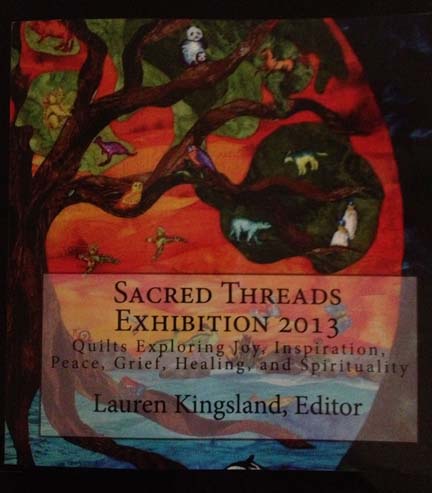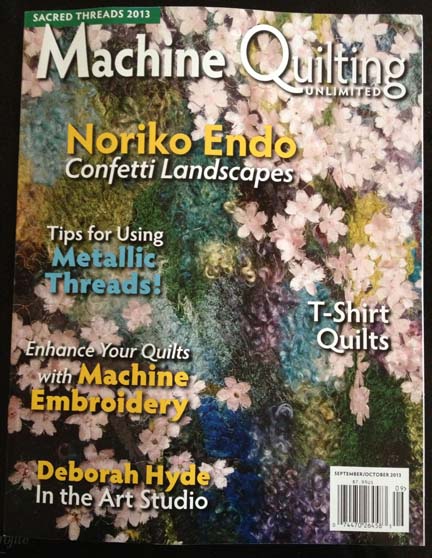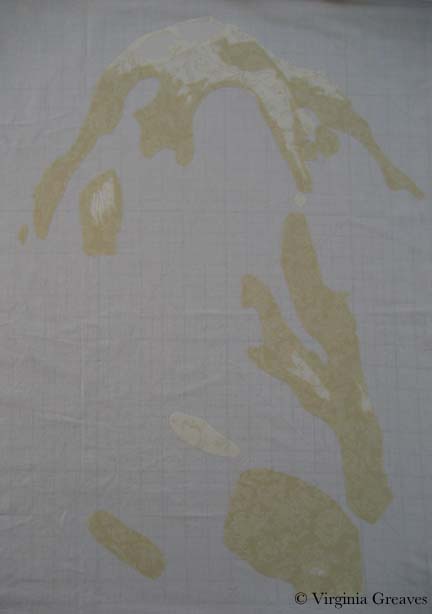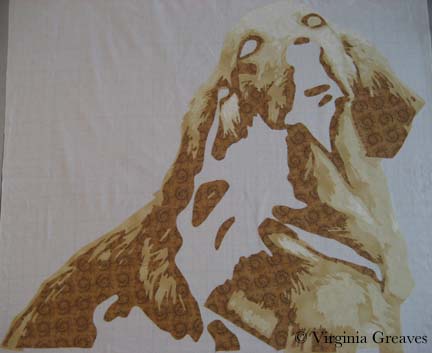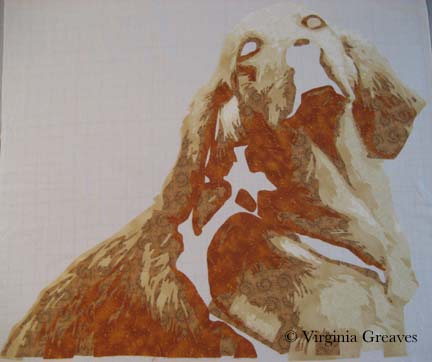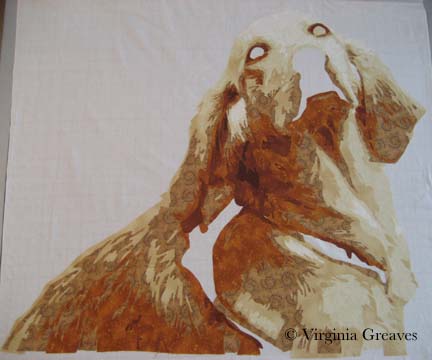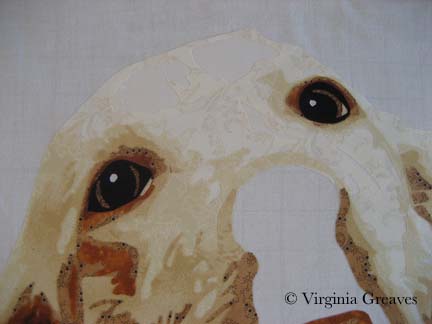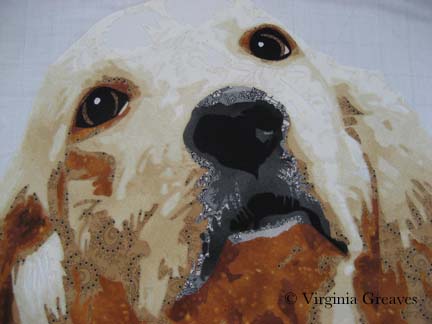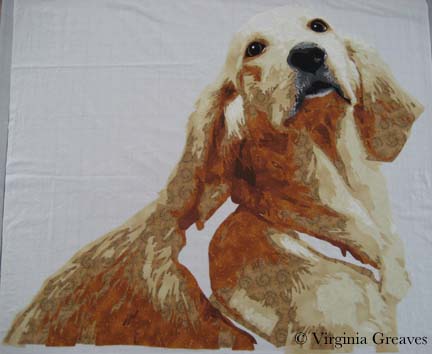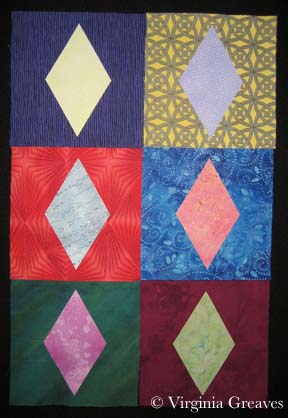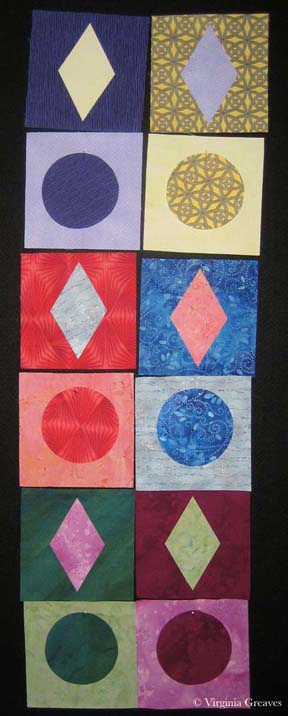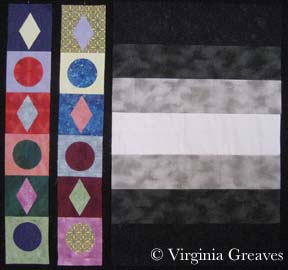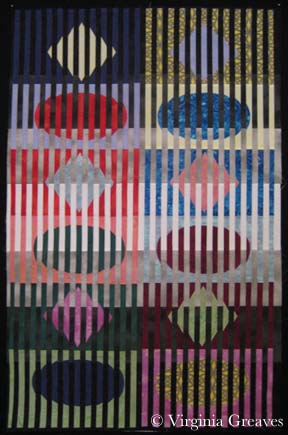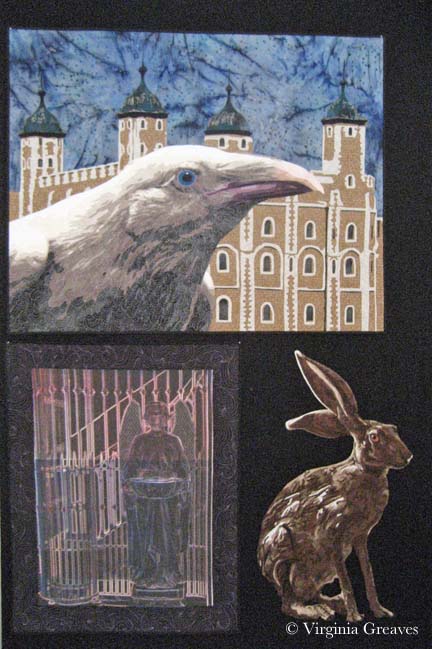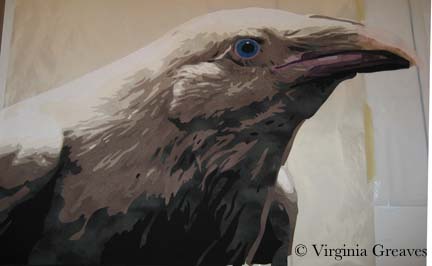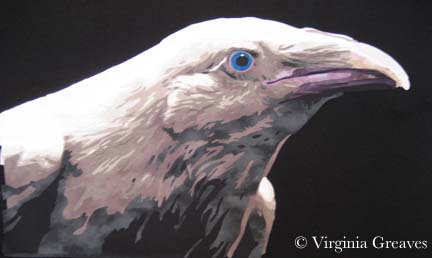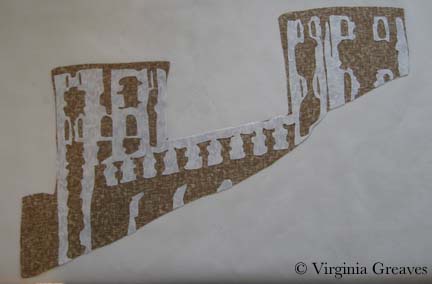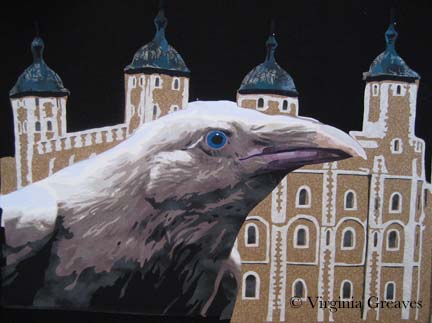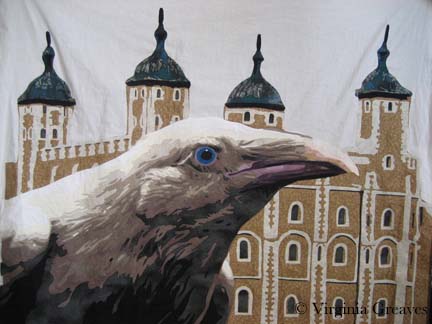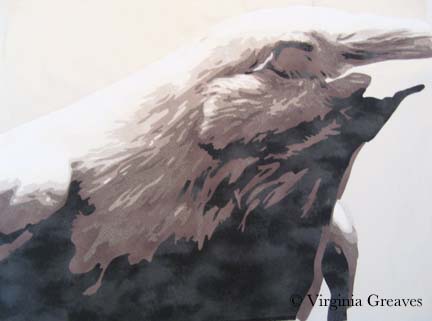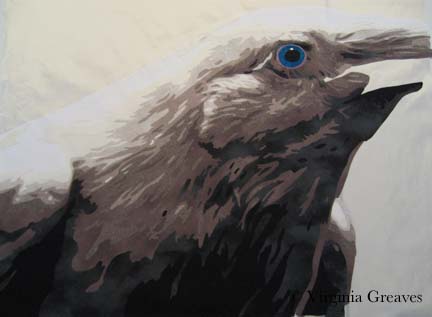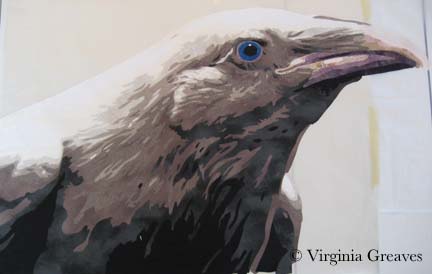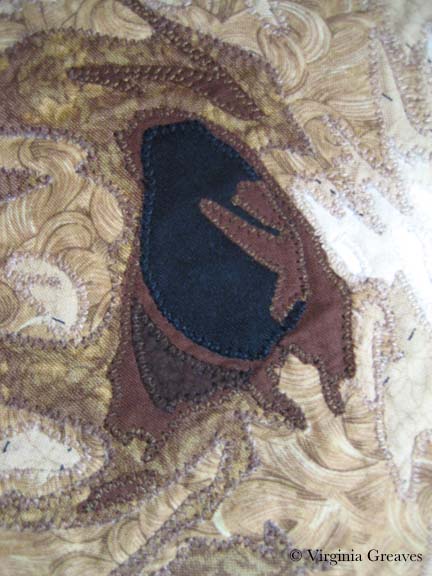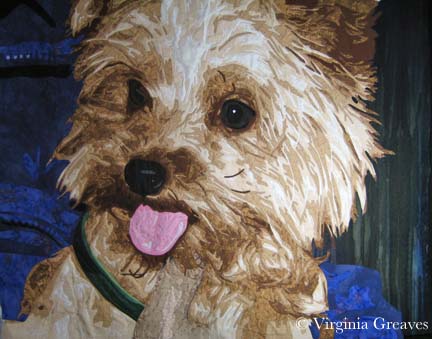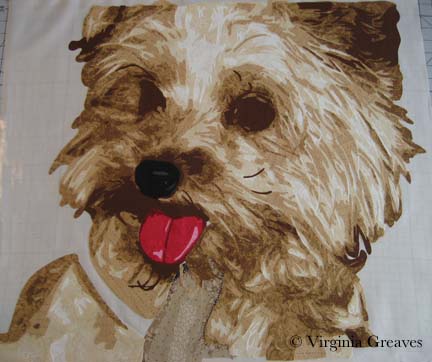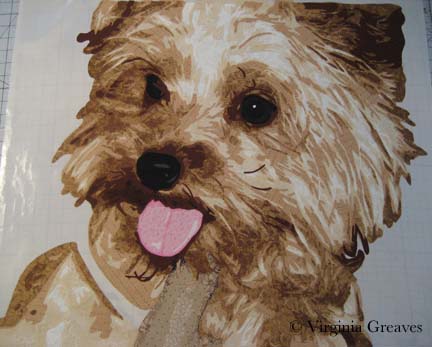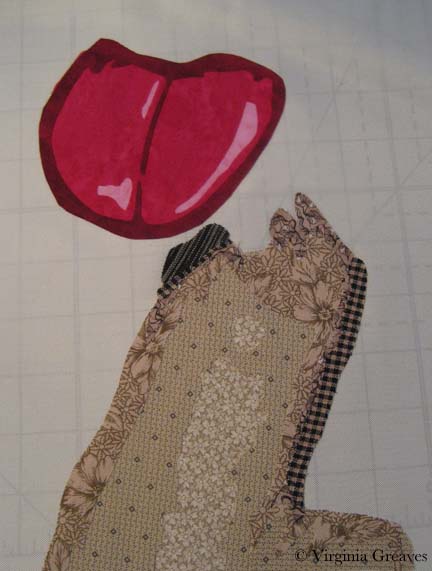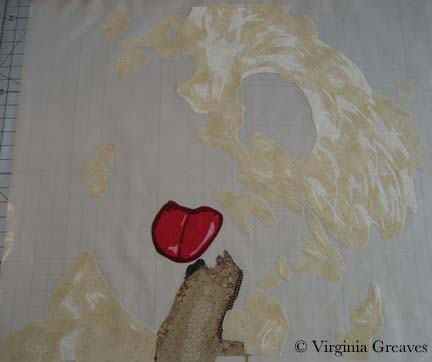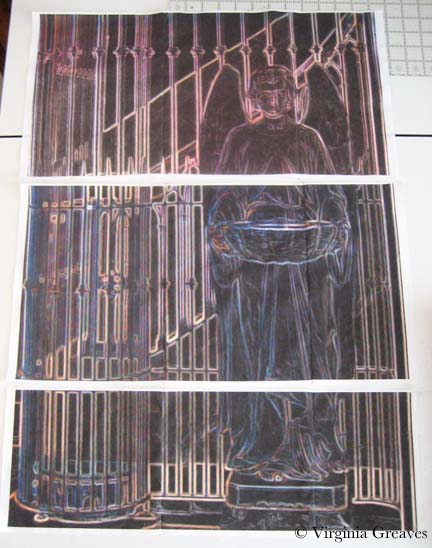Design
Design

Going to Houston
1I have been working away here on my Golden Retriever. This is what she looked like before appliqué and quilting. I have since completed appliquing her and just finished pinning her this morning in preparation for quilting.
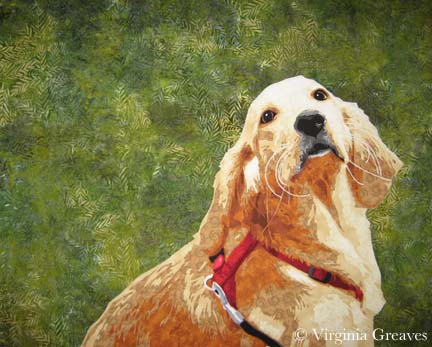 I bought several backgrounds before I settled on this batik. I didn’t want anything busy to distract from the Golden — so piecing a background was out. I also had decided to stick with analogous colors on the color wheel — so I knew yellow green was the correct color choice. The first piece I bought was a lime green that I thought would be perfect, but the minute I brought it into my studio, I knew it was wrong. I also bought a yellow green with some gray in it — which worked, but it didn’t make the Golden sing. It was just too flat. There was a batik at the store I had decided wouldn’t work because it had too much yellow in it — but at home, looking at my other choices, I knew it would work — and it does. Sometimes you have to move out of your own way.
I bought several backgrounds before I settled on this batik. I didn’t want anything busy to distract from the Golden — so piecing a background was out. I also had decided to stick with analogous colors on the color wheel — so I knew yellow green was the correct color choice. The first piece I bought was a lime green that I thought would be perfect, but the minute I brought it into my studio, I knew it was wrong. I also bought a yellow green with some gray in it — which worked, but it didn’t make the Golden sing. It was just too flat. There was a batik at the store I had decided wouldn’t work because it had too much yellow in it — but at home, looking at my other choices, I knew it would work — and it does. Sometimes you have to move out of your own way.
I have also had some exciting news — I’ve been given the honor of being invited into the Winner’s Circle at the International Quilt Festival in Houston this year for my piece Lincoln. I’ve never even been to the show before — but I’ve made my reservations and I’m looking forward to meeting other artists I’ve only met on the internet and feeling honored to be in their presence. When I find out my prize at the end of October, I’ll be sure to share.

Golden
0As I’ve mentioned before, I was lucky enough to have two pieces in the recent Sacred Threads show in Herndon, VA — Beach Guardians and The Bowl Judgments. It’s a biannual show and I haven’t participated in about four years — so I was delighted to find that the show published a book with all of the pieces from the show. Not having the ability to see the show in person, it gave me the chance to enjoy the exhibit from home and read all of the artist’s statements with time to study them alongside the work. You can order a copy of the book here.
Then a couple of weeks ago, I received a manila envelope in the mail. Inside was this new copy of Machine Quilting Unlimited and nothing else. I don’t have a subscription (although I might have to get one now — it’s really well done) — so I was confused until I saw the little strip at the top that said “Sacred Threads 2013.” I flipped to the article for the exhibit — and Beach Guardians was one of the highlighted pieces.
I was really stunned. I have never had my work included in a magazine before. I felt like I had reached a milestone. My 15 minutes anyway.
I have not been writing much on the blog lately. Part of me thinks that to have a blog, you need to write at least weekly. Another part of me really despises blog writers that fall off subject or write about nothing just to get a post out. I try to prepare something interesting and present it in a large enough piece that you can see progress. If I just showed you one day at a time, the blog would show everything in reverse order and it wouldn’t be nearly as interesting — to me anyway.
Once I had the girls back in school in August, I started thinking about my next piece. I really had no idea what I wanted to do. I started sifting through pics I took in the Spring and came across one that I really liked of a golden retriever. She is looking over her shoulder at her owner and has such a look of love in her eyes. If I found it captivating, maybe someone else would too.
I spent about a week drafting her. I typically bring the pic into Photoshop and reduce it to values only, adding lines of separation between differing objects — like the dog from her harness — or even her eyes and her nose from her fur. Then I spend a lot of time drawing in Photoshop using my Wacom tablet pen. Not only do I clean up the light scatter, I deepen shadows, add shadows to create definition, redraw the eyes, and simplify shapes.
From there, I continue the drafting process by pulling the final pattern into PosteRazor as a BMP file & scaling it to what I wanted. In this program, I can then tile print. Then I take the puzzle pieces, cut off the margins, and tape it back together. Now my pattern is back together — but larger.
Then I outline everything with an ultra thin black Sharpie. It bleeds through to the back giving me the reverse image that I’ll need for WonderUnder templates. I’ll have to go back & re-draw the lines on paper overlap — but it’s otherwise done. And FINALLY, I place a layer of see-through vinyl over the top of the pattern, tape it down, and trace it. I can then sew the vinyl to a piece of muslin (using a teflon foot that won’t stick) to use as my guide when I fuse the pieces down — or I can work on a very large fusing sheet and tape the vinyl pattern over that.
This is the beginning showing the first & second value. The first value is almost impossible to see as it’s white like the muslin background.
The third value gives you a better idea of the face.
The fourth value shows the outline of the entire dog.
The fifth value begins to give shadows and therefore definition to shapes.
The sixth value goes into an orange. There is only so far you can go with yellow — even cream. The color that shows for this value will depend largely on what is placed next to it. In the pic, it looks a lot more orange than it actually is.
The seventh value gives more depth and tones down the orange.
I debated having an eighth value — I though about just making it black — but between yellow and orange, I had room to move into a dark brown cinnamon. There isn’t a lot of it anyway.
Now the eyes. The pic normally gives me useless information here. I’ve found it best to draw them myself. The pupils are wide — and the irises are brown but has more gray in it than the brown tones in her fur. The outline of her eyes is black. You have to have a deep contrast here to feel the depth of the eye and most dogs can easily take the rich black for that function.
The nose is an experiment — although I’m leaning towards keeping it. You would think that all the fur around the mouth would match her other fur — but it doesn’t. It’s shades of back and gray.
Seeing a full picture of her, I think the nose makes sense. The gray and the black have to work together to give the impression of a snout — which I think they do.
The open patches around her shoulder are for a harness — which I’ll work on today.
I ripped off the orange under her left eye — I found it distracting.
I’m not sure about the light gray at the bottom of the mouth — I’m still considering it.
I made the entire piece without extra around the edges — which I should have done since I put her right on the muslin. Making her this way, I should have fused her to a fusing sheet where I could detach her & place her on a background. I wasn’t thinking through it — I was too excited to get to my favorite part — the cutting! I love the meditative process of fusing the shapes, cutting them out, and layering them until I start to see recognizable shapes.
I’ll have to think around what to do to correct this.

Just the Basics
0My mother is an impressionist oil painter, and when I was young and she went back to college to receive another degree in art, I remember her talking about the bias against realism in the art world. Abstract work was more highly valued — and for a very long time, I’ve disagreed with that opinion. I do like some abstract work, but I tend to be more engaged with realistic work. In fact, I’ve always felt that realism was harder to achieve than many pieces I’ve seen. That’s a huge generalization obviously — but I thought that abstract art was more about serendipitous exploration than intentional exploration.
At this point, I realize that that isn’t true — at least it isn’t true of good abstract art. It’s based on a deep understanding of color theory and how to make it work for you. I also understand why some consider it more difficult than realism. With realism, you have a point of reference from which to work. (It may not be a good point of reference, but that’s a different issue.) With abstract work, you are working entirely with theories and attempting to turn them into something engaging.
I have respect for both points of view. I work primarily in realism because that is what I like to do — but occasionally, I challenge myself to do something different — and that is what I have started here. As part of my art group’s annual exhibit, we were given playing cards to interpret. I had all ready made Jacks Are Wild — but I was given another card that I thought I could play with in a more abstract way — the six of Diamonds.
Using my color wheel, I chose six colors — starting with cyan — and then every other color around the wheel: blue, magenta, red, yellow, and green. I then picked out a light and a dark in each of these colors. Below are six 6 1/2″ squares of the dark. I know the yellow screams a little. It has a tight black pattern on it. It will make more sense when it is seen smaller and in the context of the entire piece.
Then I made six diamonds from the light values and placed them on opposite sides of the color wheel — for example, the blue background got the yellow diamond.
Of course, at this point, I know I have to make the piece longer. The challenge requires it to be 36″ long, so I decide to add squares in the light values.
They look awful blank so I decide to add a common shape — a circle — in the dark values — to place on the light colored squares. I used a round container I had in the studio for a template. It was just the right size to fill the space in the squares I had cut.
I am, by the way, appliqueing all of these shapes. I had considered piecing the diamonds onto their backgrounds — but I wasn’t going to attempt to piece a circle — so I decided I would stick with machine appliqué. This is a Wonder Under template you see below.
I have two rows of blocks. This is how they were originally laid out on the design wall, but I decided it was too predictable. I left diamonds next to diamonds and circles next to circles, but I changed the color placements so that each color wasn’t clustered with its cousins.
This was very straightforward playing with color theory. Below you can see the two strips of shapes. Not exciting enough on its own though.
I turned to my old pal deconstruction for the next part. I made a background with black, white, and a couple of grays.
Then I cut the strips of shapes into 1/2″ sections and fused them onto the background.
I’m still working on the appliqué. Even though it’s just shapes and color, does it sing? I definitely think it has a sense of movement.
I don’t know that I’ll ever work exclusively in abstract, but it’s good to dust off my skills and try something new once in a while.

Jacks Are Wild
0I am currently working on a piece for an invitational show — my third animal portrait in a row. It’s not that I’m done making portraits of people, but I’m acknowledging the marketability of an animal piece over one of a specific person. People typically see one of my portraits and say “I’d love to have you make one of my grandchildren” — which is great, but moving people from the inspiration of a commission to the commitment of one is much more difficult than them finding inspiration in a piece you’ve already made and then committing to buying it. I’ve found that if I make a piece centered around a particular breed, everyone that has had that breed as a pet can see their cute little snuggly in it.
What I’m considering here is an antelope jackrabbit. This is a very large and muscular rabbit with huge ears. This pic shows the highlights — the beginning.
I’m using my new large pressing sheet — but it still wasn’t big enough to capture the tip of the ear — so I have taped my old pressing sheet behind it to catch the space at the top.
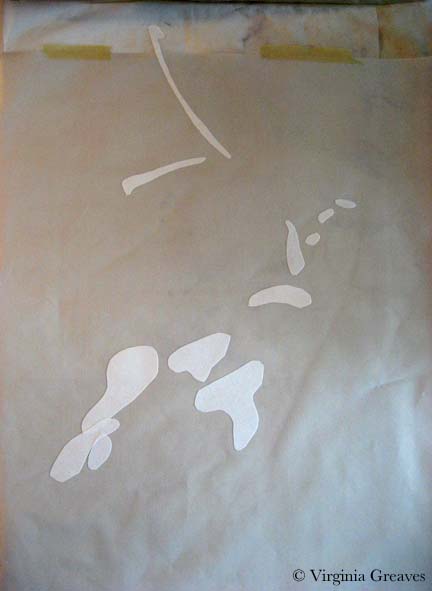
This pic shows the second value.

This shows the third value.
Once I cut the pieces small, I realized there wasn’t as much contrast between the second and third values as I saw in the comparison of larger pieces of fabric — but that’s ok. It happens sometimes. There isn’t enough of two or three to matter much.
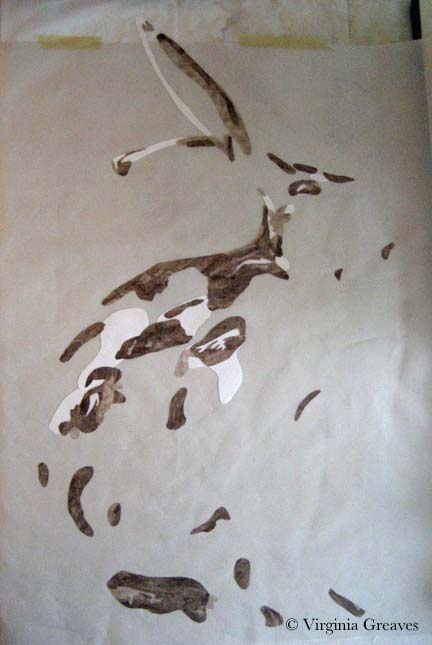
The fourth value definitely shows the creature emerging.
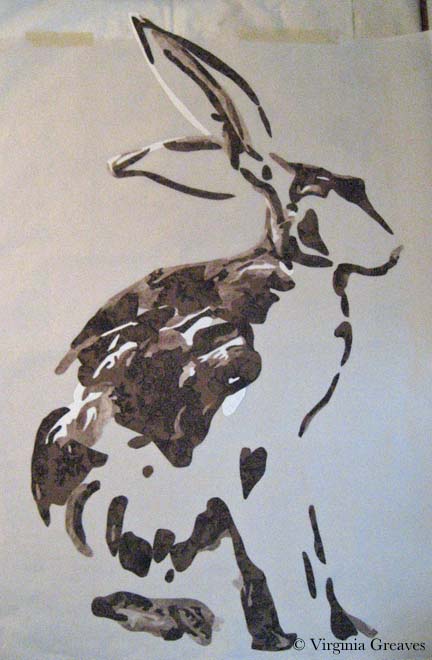
The fifth value is a fun brown I found with creatures leaping across it — rabbits as well as deer. It’s a fun detail for someone that looks close enough to find it.
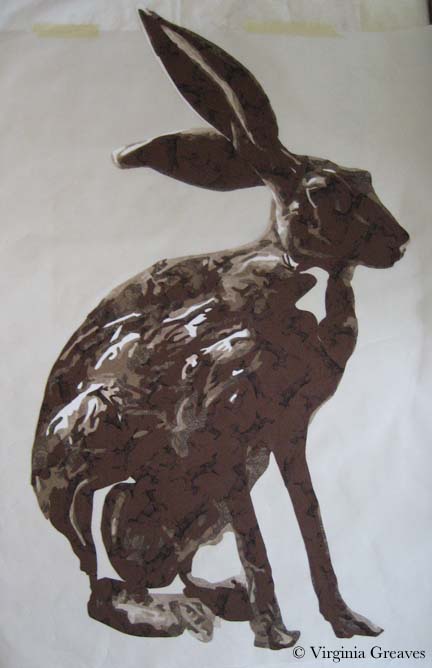
Then I finished with the sixth value of brown and then black. I completed him with an orange eyeball. This is him on my black design wall. I brightened up the pic so you could see the prints better.
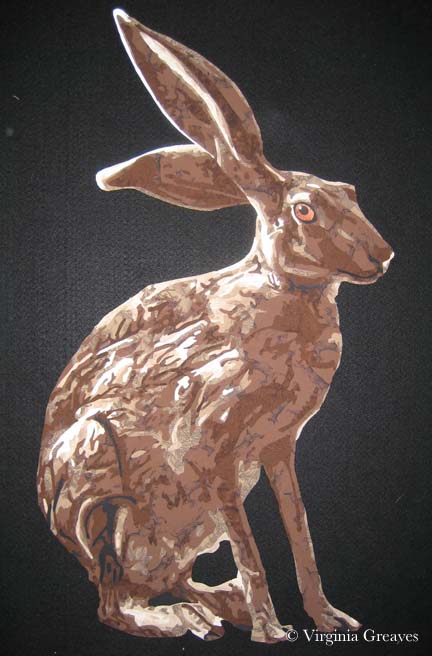
He looks at home there.
Tomorrow I’ll start thinking about where he’s going to live.

Applique and the Stabilizer Snob
0I’ve never really addressed applique on my blog. I’ve stated that I do it — I may have even specified that I use a tight zip-zag — but I’ve never really talked about it or why — which seems a great omission given how often I’m asked about it from other quilters.
Some people fuse and then go directly to quilting. I’ve considered this, especially recently. Applique is tedious and is probably the least creative process I do. However, it gives a very neat finish. Raw edge applique without it can get rather messy over time, and I like the completeness that I get with a secured edge. I’ve used a blanket stitch and a satin stitch, but I prefer a tight zigzag — 1.0 mm length & 2.0 mm width (although I vary the width in tight spaces).
Why use stabilizer? I had someone ask me that recently. Years ago, I started using stabilizer and haven’t really questioned why in a long time. The answer is that it gives a professional finish. Yes, there are many layers of fabric which can stabilize the stitch, but in some areas, only two fabrics of cotton are too flimsy. The stitch will look much better if you use a stabilizer.
For years, I’ve been using tearaway stabilizer from embroidery shops. I had one that was soluble for a while but paper-y like a tearway that I really l liked but eventually couldn’t find anymore. When I was making the raven, I used the scraps of all of my old stabilizer. They were all good — except one. We’ll get to that in a minute.
This, by the way, is the beak on my raven as I showed it in my last post. It wasn’t right.
This picture, although taken when my studio was growing dark for the evening, shows how I changed the colors a little.
The raven shows up a little better on my design wall. Whenever I lay something on my design wall, I’m tempted to just lay it on black fabric and call it a day. BUT, my intention in making this piece is part of a story — and I had plans to work on the Tower of London.
I drew a stylized version of the towers and hoped that my fabric choices would get me where I wanted to go. I had no idea if it would work — but I took a leap of faith. This shows the two right towers with the brown decorated with the white architectural details. It was almost like frosting a cake. I was careful to use a white print that wouldn’t show the brown behind it. I would usually put the lighter value down first to avoid shadowing, but this design was more structurally sound to have the full brown background with the white fabric carefully cut and laid on top.
Then I added the black details.
And finally the rusted copper turrets.
The left towers were constructed in the same way.
With the darker details and turrets added, they make more sense.
I put the towers on my design wall — and you can clearly see where the raven will sit. I posted this image to my FB Page and was surprised to find EVERYONE wanted me to finish the piece just like this. It does have a fascinating quality to it — but it isn’t the direction that I was working on. I will certainly consider it for another piece.
This shows the raven sitting on the design wall with the towers. Again, the black background makes everything look good.
This next photo shows the raven and towers once they were appliqued to muslin. Keep in mind that I had run out of my stash of stabilizer. The fabric stores only carried Pellon, and unwilling to take the time to traipse over to an embroidery store, I decided to try it. I use Pellon’s Wonder-Under all the time — how bad could their stabilizer be?
It was AWFUL. It is much thicker than any other stabilizer I’ve ever had, and it often interfered with my ability to move the fabric nimbly under the needle and get the thread where I intended it to go. It is my hope to never have to use it again. So there — I suppose I’m a stabilizer snob.
Certain in the belief that I had nothing in my stash that would do for the sky, I went to the fabric store and picked out a beautiful blue-gray — only to bring it home and find, in the bright natural light of my studio, that the fluorescents of the store had deceived me. The color was more powdery blue than what I wanted. So I searched my stash and found this funky batik. I love its contribution to the story of the piece. It’s a strange choice, but I’m happy with it. This is what the piece now looks like, fully appliqued and ready to be pinned for quilting.
Next week is Spring Break. I may not be able to begin quilting for a while, but I hope to at least get it pinned tomorrow.
One last thing — Martha Sielman has written a second book in her Art Quilt Portfolio series — People & Portraits. My piece, Celtic Woman, is on page 32. I feel privileged to be included — although I’m not overly happy with the photograph. I’ve always prided myself in taking my own pictures — but I’m missing something in terms of color. The printed picture is not anywhere near as good as what I see on my monitor. I need to start using a white balance card when photographing and re-calibrate my monitor.
I received my complimentary copy a couple of weeks ago. Beyond the thrill of having one of my pieces in publication, it’s a nice compilation of work. Several of my FB friends are included and it’s been fun to read more about their work.

The White Raven
1After finishing Firecracker, I did not have another project in mind. I spent a few days doing administrative things — donating my time to do some volunteer work — but then it was time for the rubber to hit the road. If inspiration doesn’t come, you still have to keep creating. So I went looking.
I have had a fascination for years with ravens. I have a newspaper clipping that is probably eight years old on my design wall about the ravens kept at the Tower of London. Legend tells us that if the ravens were to leave the Tower, the Tower and thus the Kingdom of Great Britain would be lost. Charles II declared that at least six be held captive there for the rest of time. Their wings are clipped and they are cared for by a Yeoman Warder.
All of those ravens are common — or black — but there are rare instances of white ravens in British Columbia, Canada. These are not albino ravens with red eyes but rather white ravens with blue eyes.
Which leads me to the inevitable question — what if a white raven were to inhabit the Tower?
There is a wonderful photographer at Qualicum which the white ravens call home — Mike Yip. He very graciously gave me permission to use one of his photographs as inspiration for this piece.
This is the first value — pure white. I started this piece in the late afternoon and the failing light gave me a yellow cast on my design surface.
The second value is almost harder to see as it has a yellow cast to it.

The third value is a little easier to see.

The next day, of course, the light in my studio was better for photography. This is the fourth value and you can really start to see the bird emerge. It is strange to think that a white bird is more than white — but even the majority of the colors in the clouds in the sky are not white. White always has a supporting cast of characters.
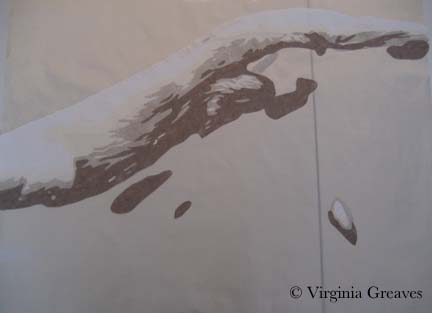
This is the fifth value.
And this is the sixth. I had to go outside my stash to find the fabrics for this piece and I had counted on 7 values — but I miscalculated — there are 8. So I took my range of fabrics, tried to figure out where I felt like there was a large enough value jump between two fabrics, and went to my fabric drawer to try to fill it. I was very lucky — I had the perfect fabric that snuggled in perfectly to what I had already set up — and that is the fabric here.
The seventh value goes into gray.
And the eighth and final value is the black.
Then I worked on her eye. I had the perfect blue in my stash. It is actually a little lighter than the blue in the photograph but I think it works well. I’m surprised at how visual I’ve become. I envisioned the exact blue that I wanted and then went to pull it from the drawer.
The beak was tricky. It has a different texture to the feathers and I knew that to make it stand out visually from what I had done previously, I needed to use different fabrics. I liked the range of pink for the top of the beak, but they didn’t work as well for the bottom.
In the photograph, the plum around her eye is repeated in the lower section of the beak — so I tried a range of plums for the lower beak. This is closer to where I want to be. There is always something in a piece that isn’t clear cut.
You’ll notice that I had to tape my smaller pressing sheet to my newer one. I never thought I would go beyond the dimensions of my ultra large pressing sheet — but it didn’t take me long to press the boundaries.
I don’t know if I’ll keep the beak the way it is, but I’ve set it aside on my design wall for now. I’m working on the Tower pieces. Once again, I loved the way she looked so much on the black, I considering giving her a plain background — but then she also looks good on the primary Tower fabric that I chose, so I’m going to experiment with that and see where it takes me.

How To Make Lemonade
1Last week I finished fusing the Yorkie. I put her up on my black design wall for a quick pic. Most things look so stunning on black.
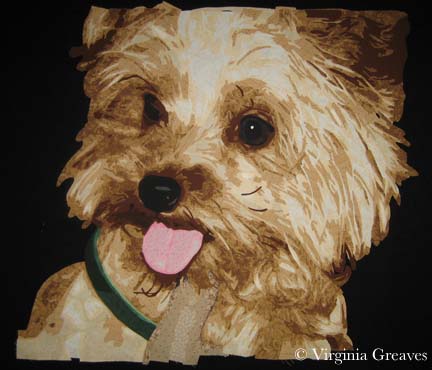
And then I started the tedious process of appliquing all of those raw edges. I use a tiny zigzag. There is so much thread in this piece from applique, I doubt there will be much stabilizer that I can tear off the back.
I did applique the piece onto white muslin. I knew that my background was going to have its own applique elements — so it was easiest to use the muslin as my canvas.
Just as I was finishing the applique on the Yorkie, Pokey Bolton announced the exhibit It’s Raining Cats & Dogs at the IQA-Houston show in the Fall. I had known about it earlier because there was an invitational exhibit that included my piece Unconditional last year — and I was told that the following year, it would be juried. So I did have this in mind as I started this piece — and I also think that animals are much more marketable than people in terms of selling my work.
However, Pokey threw me a curve ball. The minimum on any side must be 25″ — the shortest side of mine was 24″. Clearly, I was going to have to make the best of things. I threw on my creative thinking cap and starting working. I considered a border — the easiest solution — but I don’t think that that would add anything to the design. I finally decided to extend the bottom. I freeform cut it too — I felt very brave. There is more here than I’ll need but there will be some shrinkage in quilting.
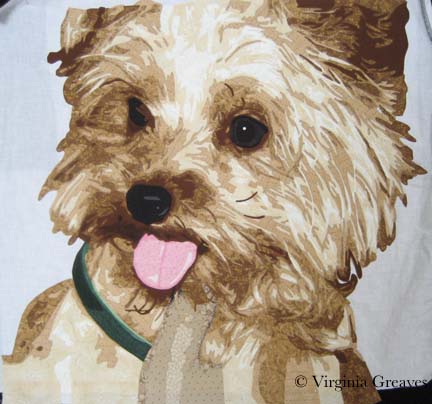
I also decided that the left eye just wasn’t cutting it. There is a sprig of hair obstructing our view of the eye, but I still felt like it needed more of the detail of the iris.
Now it makes more sense to me.
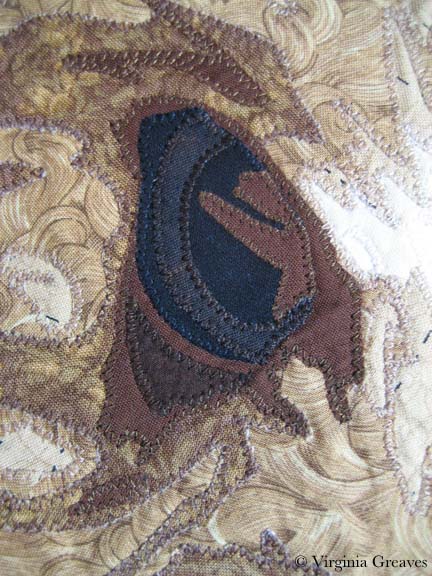
This is the final top. I have added the details of a jacket around her and the background behind the two figures.
I taught a class last week to my Fiber Art Fusion group about Color/Value & Picking Fabrics. It made me realize how dependent I’ve become on my color wheel. Can you see the tetradic color scheme (or double complement) I used? I think it works — although this is technically the hardest color combination to do successfully. I actually had no idea what to put in the background on the right — but figured out that pulling the green over from the collar but in a value deeper than the coat would work best.
So now I will start quilting. I just wanted to share with you how this little piece was coming along.

Little Dog Personality
2The hard work done, I began last week to add the final dark values to my Yorkie. This shows the fifth value.
And this shows the sixth value. She really comes alive once the deeper values have been established.
And here I’ve added her black nose.
I actually had marked some black spots around the mouth, but they didn’t make sense at all — so I added a seventh value. It’s subtle but it’s still nice to have. I also ripped off that red mouth. Now that I had the dark values laid out, I knew it was a mistake.
This is my newest take on the tongue. I took what was previously my lightest value & made it my darkest one. It seemed odd to me — but her tongue is really a light pink — a blush with a lot of white on top of it. I even managed to stay within my stash at home — which I didn’t originally think I could do (I don’t have much pink fabric on hand).
After that, I worked on the detail in the eyes. The left one is not really visible — she’s turned to the side and it’s obstructed by her hair curling out over it — but the right eye is detailed. Her iris is yet another really dark brown. It’s not much different from the black in value — but it needs the break to define the eye.
Today I’m studying my color wheel and thinking about what to use for her collar and the background.

Yorkie
0For Christmas, I received this wonderful large applique pressing sheet. My old one is 18″x18″ — and I’ve done some larger pieces that made it difficult to do it off of a base like muslin.
To be honest, I don’t love it. I taped my vinyl overlay on top of it — placed it on my work table with the ironing cover — but when I iron the pressing sheet, it holds the heat a long time. If I place the vinyl overlay back on top too soon, it melts and shrinks the vinyl. (Ask me how I know.) My old sheet is made from a different material and I never had this issue.
Anyway, I started working on my Yorkie last week. I know — it’s a complex pattern. The only way I could begin to keep track of it was to cover it with Sharpie in different colors.
This shows the finger in front of the dog. It will be surrounded by fur.
And this shows her tongue. I have reservations about the tongue — but because it’s all constructed on the pressing sheet, I can always rip it off later.
This shows the first value of the Yorkie. Not a lot to see yet.
The second value shows more definition.
And the third value really brings out her personality. This layer was painful to do. Can you tell? There was a lot to keep track of.
And this is the fourth layer. Also difficult. I like the way the fabrics are working together though.
I’ve just finished the fifth layer today and have started on the sixth — then I’ll go back & add the black, the eyes, the collar around her neck, and finally the background.
I have been working on only fabrics in my stash. In some cases, I had little fabric to work with. The third layer I actually ran out of — but I remembered where I bought it a year ago and took a scrap back in the hopes that they still had some. The fabric angels were smiling on me that day — the woman at Tiny Stitches went into the back and came back with a very small bolt. She said she couldn’t sell me much because it was on hold for their embroidery group, but I only needed a small amount.
The fourth layer was also close — I made all of my patterns and placed them on the fabric before I started for fear that I would run out of it.
Next week, I’m speaking at my Fiber Art Fusion group on Color/Value & Choosing Fabrics. I’ve been writing out some notes but need to pull out fabrics to take with me. It’s hard for me to pull out of a project once I’ve sunken into it. It’s like becoming a hermit and it’s difficult to focus on other things.

The Dark Angel
1If you’ll remember, back in December I made a 5″x7″ piece for my art group holiday exchange entitled Dark Angel.
I loved it so much that I decided to use it as a study for a larger piece. It also coincides nicely with a show for which it is appropriate (although we’ll have to wait and see on that.)
I had my original image — and the image that I had manipulated in Photoshop and resized to 5″x7″. Interestingly, when I took the original image — which was larger — and tried to recreate the effect, I couldn’t. I need to take better notes as I work. So I was forced to upsize the small file. This has to be done carefully or the image quality will suffer greatly.
In Photoshop, I increased the size in 15% increments using bicubic resampling and then using the unsharp mask tool. I think it came out well.
I printed these out onto Jacquard cotton inkjet fabric sheets. (I considered sending it out to a commercial printer, but they all wanted minimum order sizes and I couldn’t justify the expense.) After printing them out, I sprayed them lightly with Scotch-Gard and let them dry.
I knew that sewing this piece together would be tricky. I had used PosteRazor to print them out and didn’t specify a border — and wouldn’t you know, my top border came out shorter than 1/4 inch.
I could have reprinted them, but given the expense of the sheets and the printer ink, I decided to make do with what I had. I used a lightbox to align pieces before sewing them together. I made sure that I couldn’t see a shadow of the one underneath — and then I glued them together. Yes — I glued them. I’ve been using the trick of ironing clear Elmer’s glue instead of pins when applying binding and it works so well I thought I would use it here as well. I used as little as possible though.
I used my open toe foot and sewed just inside the printed image so I wouldn’t see any of the white border on the front.
This shows the three rows sewn together. I did, by the way, iron the seam allowances to one side to add some durability to the seams that were cheated a little in fabric and also to help the rows sew together straighter (sewing a left and a right opposing seam together is more likely to give you a perfect match in the middle).
This is the final piece — well, before quilting and finishing. I will spray it again with Scotch-Gard one last time before I start quilting.
